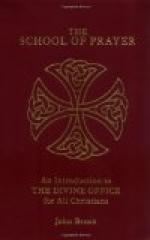Dom Baudot’s The Roman Breviary gives in an appendix, pp. 239-252, “tables showing the date at which each saint was inserted in the Roman Breviary, the rank given to his festival, and the variations it has undergone. It is often difficult to give precise dates.”
ROGATION DAYS, EMBER DAYS AND LITANIES.
“Litanies were solemn supplications instituted to implore the blessing of Heaven on the fruits of the earth. It was customary to recite them in the spring, that is, the season of late frosts, so much dreaded by the cultivators of the soil.... The people marched in procession to the spot, chanting the while that dialogue prayer which we call a litany, elaborated, according to circumstances, into a long series of invocations, addressed to God and to angels and saints.”
“The day set apart for this purpose at Rome was the 25th April, a traditional date, being that on which the ancient Romans celebrated the festival of the Robigalia....
“The most ancient authority for this ceremony is a formulary for convoking it, found in the Register of St. Gregory the Great, which must have been used in the first instance in the year 598” (Duchesne, Christian Worship, chap, viii., n. 9).
Ember days, a corruption from Latin Quatuor Tempora (four times). “The purpose of their introduction, besides the general one intended by all prayer and fasting, was to thank God for the gifts of nature, to teach men to make use of them in moderation, and to assist the needy. The immediate occasion was the practice of the heathens of Rome. The Romans were originally given to agriculture and their native god belonged to the same class. At the beginning of the time for seeding and harvesting religious ceremonies were performed to implore the help of their deities; in June for a bountiful harvest, in September for a rich vintage, and in December for the seeding.... The Church when converting heathen nations has always tried to sanctify any practice which could be utilised for a good purpose.” The fasts were fixed by the Church before the time of Callixtus (217-222). The spread of the observance of Ember days was slow; but they were fixed definitely and the fast prescribed for the whole Church by Gregory VII. (1073-1085). (Cf. Catholic Encyclopedia, word, Ember Days; Duchesne Christian Worship, chap, viii.; Dom Morin Revue Benedictine, L’Origine des Quatre Temps, 1897, pp. 330-347.)
NOTE A.
THE BREVIARY HYMNS.
Of all the many and varied branches of Christian art, there is none which offers to the researches of criticism a field so extensive as does the hymnography of the Roman Breviary. No other source of liturgical study, if we except the antiphonarium, has received such attention from studious men. But never, in any age, did this study receive such careful treatment and give rise to such patient and laborious research as in our own. (Pimont, Les hymnes du Breviare Romain, Introduction.)




